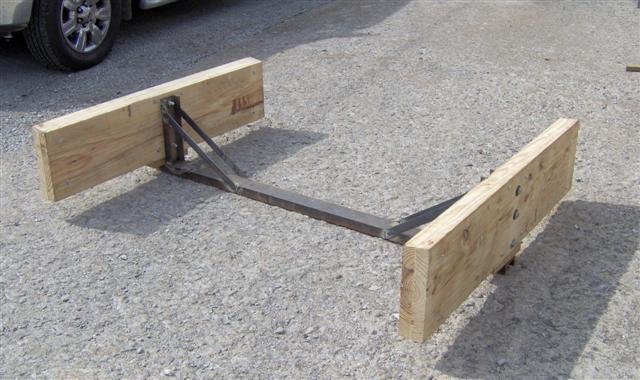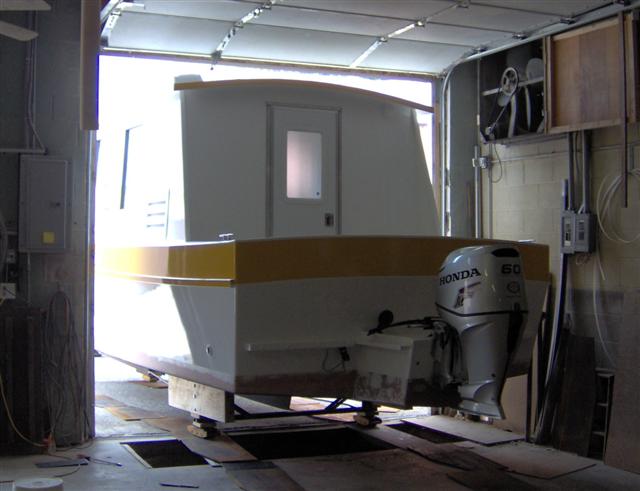|
By June 2, 2010 building had progress to the point it was time for the True Grit to exit the shop and begin residency on the trailer. Building a boat this size presents many challenges but for me these two final task ranks near the top. Sitting there flat on the floor was 5300 pounds of structure that was 8'6" wide and 9'4" tall and 31' long (including the outboard). It needed to be lifted off the floor and moved bow first through a 10' x 10' door. I had spent many hours lying awake in the middle of the night trying to sort out the best method to accomplish this with the resources I had available. Now it was time to see if the resulting plan would work or just prove to be a pointless loss of sleep. The first task was to fabricate a fixture that would both support the boat and allow it to be rolled. One major problem was that overhead clearance limited the amount I could lift it. The laser level reported that 8" was the maximum clearance available to get it off the floor and on some type of rolling device. I was leaning towards long beams used to support the hull and resting them on lengths of pipe used as rollers. This would have worked well on a totally level shop floor but once outside the concrete slopes down to a small drainage gutter and then the roadway pitches back up. This would be somewhat of a problem but beam / pipe idea was the best solution I could develop. Then one day at lunch at our local Subway Sandwich Shop I was discussing the build with two friends at the next table. They work for a small construction company and deal with large equipment on a regular basis. They ask how I intended getting it out of the shop and I offered up my "beam / pipe" solution. They weren't impressed and told to follow them back to their shop as they thought they had something that would help. Once there they pulled off the shelf what resembled very heavy roller skates. They said that even one of these would support the entire weight of the boat! Plus, the rollers had a rotating disk on the top which would allow then to be "bumped" around to steer in the direction needed. With their boss's blessing I hauled three of them out to my truck. Now my mind was going into overdrive - these were going to make all the difference!
From the
photos
you can somewhat see what developed. I decided on a
three-point undercarriage as it would allow the
assembly to self adjust as the uneven ground was
encountered. One
roller at the bow would have a tongue attached,
which would be hitched to my 50-year-old
tractor. From there I made two 13' rods
from 1/2" electrical conduit that ran back
to the aft structure. Aft
I welded together a frame from scrap 3" steel
channel (left over from the Cabin Skiff's
trailer build) and attached two 5' bunks made
with double pieces of 2" x 12".
A roller was placed at each corner. All up it raised the
boat up 6" leaving 2" to spare plus gave me a
way to easily steer it out the door and around
the corner. A friend
that volunteered to help with the
move commented because he knew me so
well, he was surprised I had not
drawn the entire thing out in a CAD
program to see if it would clear ( I
do tend to over think things). I told him
I had seriously considered doing
just that but was afraid I would
discover it wouldn't fit out the
door - So I decided against it!
The last piece of the moving puzzle was the need for a smooth surface for the rollers. In my shop the concrete was fine but once outside there was a rough salt eaten slab and an oiled & chipped alley to deal with. A visit to another friend's large machine shop yielded a stack of 5/16" steel plates measuring about a foot wide and 3 feet long. They were cut-offs from a job several years ago and he said I could use as many as I needed. So that was it. They would provide a steel pathway out of the shop and into the alley. (The above photo is THE MOVING CREW - myself, Glen Galle and Jerry Franklin)
Once moved from the shop the next hurdle would be to get it on the trailer. My friend with the machine shop has a 15-ton crane I could have borrowed (many, many years ago I ran one on a daily basis) but the alley has numerous overhead power and phone lines which would prevent it use. I decided I would have to use floor jacks to make the lift. But then again at Subway for lunch talking to the construction guys about getting it on the trailer they offered up another suggestion. They said for me to talk with the construction company's owner as he makes heavy lifts all the time and he might have some suggestions. I gave him a call and he came by to take a look and said this wasn't a big deal. We could jack up the transom but he would just bring in one of his small mobile "yard cranes" and lift the bow while we backed the trailer under it. He said to pick a date and he would bring the crane by along with his two workers and we would put it on the trailer. Needless to say, I was smiling from ear to ear!
The welded up aft hull support. One inch construction foam sheets were added between the hull and the bunks for protection. Here is the aft support in place under the hull. The odd shaped yellow unit is the heavy duty roller. Actually it consist of three 2" diameter rollers each about 4" long mounted in a steel frame. Under the roller is the steel plates used to smooth concrete and asphalt surface. We posistioned these as needed to make the turn going out the door.
**********************************
The day of the move came and I was understandably a little wired. A lot was going to happen and though a positive end result was anticipated there were many things that could change that outcome. About 10AM two friends and myself started the roll out. The plan was to take our time and inch our way out the door. This photo is a little confusing. The bow is resting on the support (a section of 8" I beam on it's side) with a roller under it. Attached to the support and extending to the left is the tongue used to pull the boat out. The plates are extending over an opening in the floor for the basement stairs. Originally there was not a garage door here which explains the odd placement of the stairs. Actually it works well as a "pit" when working on cars and such. Coming out the door.
Aft end over the stairway opening.
Crossing the gutter and making the turn. Out of the shop, in the middle of the alley and ready for the trailer.
Much to my relief and surprise it went amazingly well. We steered the boat through the doorway and out on to the road. At one point we managed to get one roller off the plates and had to jack it up to fix it but other than that there was no problems. The rollers were the key as they allowed us to move the bow to one side while the transom could move to the other. I never dreamed it would go so well. In an hour we were out the door and sitting at 90 degrees in the middle of the alley. I couldn't believe it. After hours and hours of thought and worry it was all over that quickly!
|


